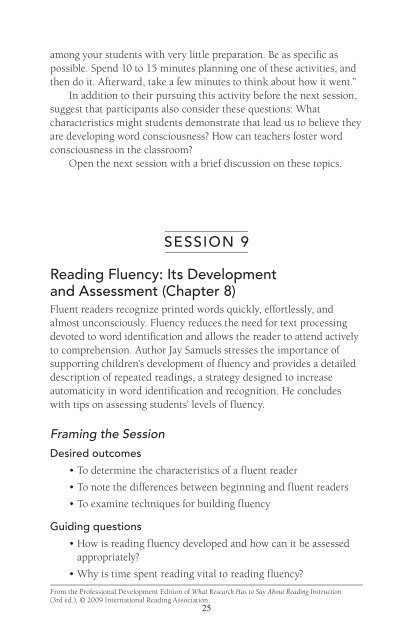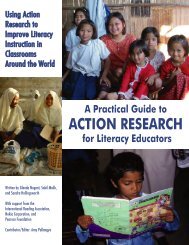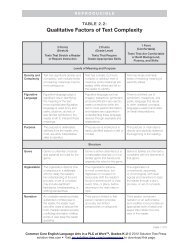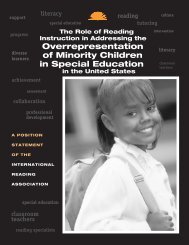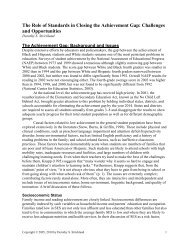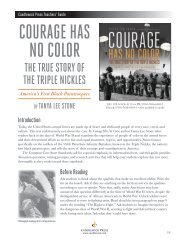What Research Has to Say About Reading Instruction - International ...
What Research Has to Say About Reading Instruction - International ...
What Research Has to Say About Reading Instruction - International ...
You also want an ePaper? Increase the reach of your titles
YUMPU automatically turns print PDFs into web optimized ePapers that Google loves.
among your students with very little preparation. Be as specific as<br />
possible. Spend 10 <strong>to</strong> 15 minutes planning one of these activities, and<br />
then do it. Afterward, take a few minutes <strong>to</strong> think about how it went.”<br />
In addition <strong>to</strong> their pursuing this activity before the next session,<br />
suggest that participants also consider these questions: <strong>What</strong><br />
characteristics might students demonstrate that lead us <strong>to</strong> believe they<br />
are developing word consciousness? How can teachers foster word<br />
consciousness in the classroom?<br />
Open the next session with a brief discussion on these <strong>to</strong>pics.<br />
SESSION 9<br />
<strong>Reading</strong> Fluency: Its Development<br />
and Assessment (Chapter 8)<br />
Fluent readers recognize printed words quickly, effortlessly, and<br />
almost unconsciously. Fluency reduces the need for text processing<br />
devoted <strong>to</strong> word identification and allows the reader <strong>to</strong> attend actively<br />
<strong>to</strong> comprehension. Author Jay Samuels stresses the importance of<br />
supporting children’s development of fluency and provides a detailed<br />
description of repeated readings, a strategy designed <strong>to</strong> increase<br />
au<strong>to</strong>maticity in word identification and recognition. He concludes<br />
with tips on assessing students’ levels of fluency.<br />
Framing the Session<br />
Desired outcomes<br />
• To determine the characteristics of a fluent reader<br />
• To note the differences between beginning and fluent readers<br />
• To examine techniques for building fluency<br />
Guiding questions<br />
• How is reading fluency developed and how can it be assessed<br />
appropriately?<br />
• Why is time spent reading vital <strong>to</strong> reading fluency?<br />
From the Professional Development Edition of <strong>What</strong> <strong>Research</strong> <strong>Has</strong> <strong>to</strong> <strong>Say</strong> <strong>About</strong> <strong>Reading</strong> <strong>Instruction</strong><br />
(3rd ed.), © 2009 <strong>International</strong> <strong>Reading</strong> Association.<br />
25


